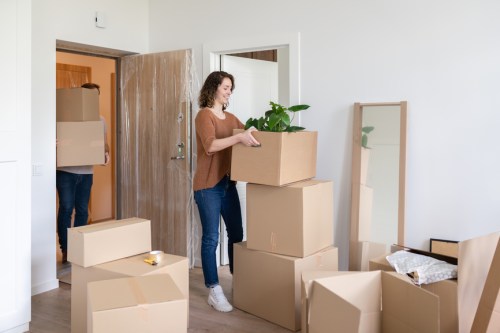It’s a popular time to relocate as people reconsider their priorities when it comes to the meaning of home. The need to go into the office every day is less pressing, and there’s a greater ability and desire to take on a work-from-home lifestyle without compromising routine and performance. If you’re planning to move, you’ll likely want to bring your plants with you wherever you go. But there’s a right way to do it that keeps plants happy on the journey and after you arrive at your new digs.
Experts in This Article
gardner, blogger, and founder of DIY Garden
Yes, much like adults, plants “feel” the emotional effects that can come with a transition into a new living space, so they’ll need your help. Plants are best transported both in a car and with you, so you can make sure they’re upright and not left in high temperatures, but this isn’t always practical. Moving companies have policies on moving plants, so check the policies first to figure out what’s even possible. In many cases, they won’t take them at all or they might want a disclaimer.
You can move with plants via air freight, but an airline won’t provide any extra care for your plants to ensure they’re safe, and they’ll unfortunately get the same treatment as standard goods’ get (which is pretty basic and at the bare minimum).
These are the best preparations and special care measures required to ensure that you move with plants most efficiently and that they arrive safely, without any scratches or trauma.
How to move with plants
1. Use sufficient packaging
“Foliage is especially vulnerable in cars, vans, and airplanes and needs secure packaging to stand a chance of arriving in one piece,” says Clive Harris, gardening expert and founder of DIY Garden, one of the United Kingdom’s top gardening blogs.
Make sure your plants are packaged enough for full protection across all areas of the plant during the move, as well as ample availability for hydration intake. It’s possible for plants to become dehydrated both prior to and during transportation, so keep fluids on hand to nourish and hydrate your plants.
“It’s also important to make sure your plants don’t dry out in the hectic days of packing, moving, and unpacking when your mind is on other things,” says Harris. According to Harris, all houseplants need a good soak in the sink a few days before packing.
Pay attention to watering them well a few days before the move and packaging most effectively to keep them secure and most safe inside a strong, durable box for support. “Ensure they’ve drained freely and their soil is still partially damp on moving day, as this will make sure they have enough water to cope with a few days on the move,” he explains.
2. Wrap the foliage in newspaper if needed
Packaging demands can vary based on the type of houseplant you’re moving with, but there are a few common plants that require newspaper as part of the packaging, as a way to guarantee safety during transportation. “Newspaper lets it breathe and gives some protection for its foliage,” says Harris.
“Plants with long, leafy foliage can get flattened or squashed on the move so the best way to prep is to gently wrap the foliage in newspaper and secure the newspaper with Sellotape,” says Harris.
One plant that’ll need to be wrapped in newspaper for the journey is the orchid. “If you fully open a sheet and start at the base, winding newspaper around the container will naturally wind it around the top too, and if your orchid is flowering, take another step to ensure it’s securely clipped to the supporting stake where it won’t bounce around in transit,” says Harris.
Monsteras also need newspaper wrapping for the big move. “If your plant is standing tall on a mossy pole, secure it gently and wrap the newspaper around its container, slowly working upwards,” says Harris. “If the plant is a trailing vine then wrap the vines gently around the base of the plant so they rest on the soil, before then wrapping newspaper around the container, as above,” says Harris.
For an even smoother move with plants, put all leafy newspaper-wrapped houseplants together in a tall box with a strong lid, and then stuff gaps between pots with more newspaper to keep them upright. “This creates a safe, humid environment they’ll feel comfortable in,” says Harris.
3. Package some plants individually to protect the others plants as you move
“Succulents and cacti, for example, should be put in a separate box with sturdy foam or packing paper between pots to keep them upright and upon arrival, you should open the lid as soon as possible and put them in direct sunlight to recover,” says Harris.
Since they’re spiky in nature, the exterior of the succulents can be dangerous to other plants, if packaged together during the move. Their spines can unfortunately tear leafy plants apart, so keep them in different boxes and away from the others!
4. Label your plants to keep track of them
Leave all box lids open up until the very last minute, and be sure to then label accordingly so you don’t lose track of which plants are in which containers. This will maximize light absorption before they are plunged into darkness for hours or even days.
Don’t forget to write the names down to make caring for and unloading the plants easier once arriving at your destination. And as another final step, line the base with plastic bags. “Lining the base with plastic bags stops leakage, too, which is helpful since if the base disintegrates, your plants will fall out and smash,” says Harris. Line the base of boxes with plastic, and you’ll be able to prevent any damp soil from rotting cardboard and causing a disastrous fall out.
How to help your plants recover from moving
Houseplants don’t always appreciate the shock of moving. They’ll need help adjusting to their new environment to feel more at ease and comfortable (just like you).
“For example, fiddle leaf fig plants shed their leaves to adjust to new light conditions and don’t even appreciate moving from living room to bedroom in the same house,” says Harris. Be patient and attentive when you move with plants, especially those requiring extra love and support.
1. Open all box lids as soon as you can
Your plants need light and air to thrive, so give it to them as soon you’re unpacked. “Plants don’t like the permanent night of a sellotaped box and will start to shut down almost immediately,” says Harris. So, let them out into the sunlight ASAP once they arrive.
2. Place each plant in a location it enjoys most
“Leafy rainforest natives like the light shade and succulents or yuccas prefer full sun,” says Harris. And make sure to mist your leafy plants to increase their humidity and moisture, as well as to rebuild strength.
3. Remove flowers if needed
If plants start to wilt or tend to look sick after the move with your plants, remove the flowers so their energy can go into recovery. “Ferns bounce back well if you remove damaged or browning foliage,” says harris, providing an example.
4. Keep an eye on light levels and heat
You’ll be busy moving into your new home and might not notice your monstera is catching direct sunlight in the late afternoon, but you might regret that shortly after. “This will scorch its leaves, and when combined with moving shock, may well kill it,” says Harris. Make sure the plants are in their optimal living spaces in the new home for ideal levels light.
5. Give your plants extra nutrients
“A very weak feed of houseplant fertilizer will boost their nutrients, especially in summer,” says Harris.
6. Give it time
Much like with all things related to humans and transitions, whether into new roles of responsibility, living spaces, or within new relationships, you must be patient. “In the majority of cases, it’ll take a few weeks for a plant to adjust and recover completely,” says Harris. This might mean a few weeks or even several months.
The best plants to put in every room of your house:
Oh hi! You look like someone who loves free workouts, discounts for cutting-edge wellness brands, and exclusive Well+Good content. Sign up for Well+, our online community of wellness insiders, and unlock your rewards instantly.
Sign Up for Our Daily Newsletter
Get all the latest in wellness, trends, food, fitness, beauty, and more delivered right to your inbox.
Got it, you've been added to our email list.











